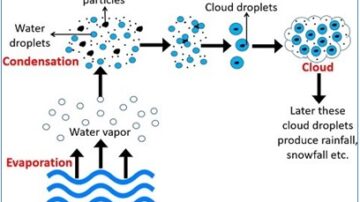Allah Almighty stated in the verse 15:22 of Al-Qur’an that:
وَأَرۡسَلۡنَا ٱلرِّيَٰحَ لَوَٰقِحَ فَأَنزَلۡنَا مِنَ ٱلسَّمَآءِ مَآءٗ فَأَسۡقَيۡنَٰكُمُوهُ وَمَآ أَنتُمۡ لَهُۥ بِخَٰزِنِينَ﴾ [الحجر: 22])
“And We have sent the fertilizing winds and sent down water from the sky and given you drink from it. And you are not its retainers.” [Saheeh International]
Allah bestowed us with the Divine blessing, proving the wonderful source of water as stated in this verse. His blessing of water is not only for the human beings but also for the animals, plants, and other creatures living on the Earth, as what we see in some other verses of Al-Quran.
Stated in the verses 16:10-11 that:
هُوَ ٱلَّذِيٓ أَنزَلَ مِنَ ٱلسَّمَآءِ مَآءٗۖ لَّكُم مِّنۡهُ شَرَابٞ وَمِنۡهُ شَجَرٞ فِيهِ تُسِيمُونَ﴾ [النحل: 10])
“It is He who sends down rain from the sky, from it is drink and from it is foliage in which you pasture.”
(يُنۢبِتُ لَكُم بِهِ ٱلزَّرْعَ وَٱلزَّيْتُونَ وَٱلنَّخِيلَ وَٱلْأَعْنَـٰبَ وَمِن كُلِّ ٱلثَّمَرَٰتِ ۗ إِنَّ فِى ذَٰلِكَ لَـَٔايَةًۭ لِّقَوْمٍۢ يَتَفَكَّرُونَ)
“He causes to grow for you thereby the crops, olives, palm trees, grapevines, and of all the fruits. Indeed in that is a sign for a people who give thought.”
Similar verses are 25:48-49:
(وَهُوَ ٱلَّذِىٓ أَرْسَلَ ٱلرِّيَـٰحَ بُشْرًۢا بَيْنَ يَدَىْ رَحْمَتِهِۦ ۚ وَأَنزَلْنَا مِنَ ٱلسَّمَآءِ مَآءًۭ طَهُورًۭا)
[الفرقان: 48]
“And it is He who sends the winds as good tidings before His mercy [i.e., rainfall], and We send down from the sky pure water.”
(لِّنُحْـِۧىَ بِهِۦ بَلْدَةًۭ مَّيْتًۭا وَنُسْقِيَهُۥ مِمَّا خَلَقْنَآ أَنْعَـٰمًۭا وَأَنَاسِىَّ كَثِيرًۭا)
[الفرقان: 49]
“That We may bring to life thereby a dead land and give it as drink to those We created of numerous livestock and men.”
Role of Ar-riaaha lawaaqiha (ٱلرِّيَـٰحَ لَوَٰقِحَ)
The first part of verse-15:22 is,
وَأَرْسَلْنَا ٱلرِّيَـٰحَ لَوَٰقِحَ
“And We send the fertilizing winds.”
Arabic “Ar-riaaha lawaaqiha (ٱلرِّيَـٰحَ لَوَٰقِحَ)” is translated by many interpreters as “fertilizing winds.” The “lawaaqiha (لَوَٰقِحَ); fertilizing” qualifies the word “Ar-riaah (ٱلرِّيَـٰحَ); winds,” mentioned in this verse. The “lawaaqih” is also translated as: fecundating [Yusuf Ali], and impregnating [Dr. Ghali] that are synonyms of fertilizing. We should say that Allah sends the winds of having these characteristics and sends down rain from the sky.
Taking all the translations into account, the “lawaaqih,” literally, refers to the following three roles of the winds:
- to fertilize two substances and form a new substance (clouds in this case) similar to the “zygotes” in humans and animals;
- to produce fertilizers for the plants, crops, etc.; and
- to fertilize (pollinate) the plants.
It is to be noted that, Allah stated first, “And We send fertilizing winds” and next, “and (We) sent down water from the sky.” It is obvious that the sky has to be filled with clouds before sending down water from the sky. So, there is a linkage between the statement of the verse: “We send fertilizing winds,” and the “formation of clouds in the sky.” And this linkage is clearly mentioned in the verse 30:48 of Al-Quran:
ٱللَّهُ ٱلَّذِى يُرْسِلُ ٱلرِّيَـٰحَ فَتُثِيرُ سَحَابًۭا فَيَبْسُطُهُۥ فِى ٱلسَّمَآءِ كَيْفَ يَشَآءُ وَيَجْعَلُهُۥ كِسَفًۭا فَتَرَى ٱلْوَدْقَ يَخْرُجُ مِنْ خِلَـٰلِهِۦ ۖ فَإِذَآ أَصَابَ بِهِۦ مَن يَشَآءُ مِنْ عِبَادِهِۦٓ إِذَا هُمْ يَسْتَبْشِرُونَ
“It is Allah who sends the winds, and they stir the clouds and spread them in the sky however He wills, and He makes them fragments so you see the rain emerge from within them. And when He causes it to fall upon whom He wills of His servants, immediately they rejoice.”
Existing Interpretations
The existing interpretations of “fertilizing winds” mostly focus on the “formation of clouds and rain in the sky,” and do not focus on the fertilizer production issue.” Some interpreters explain it as fertilizing the clouds into rain. Other interprets it as “the winds impregnated by rain or the winds having clouds and rain in it.” Ibn Kathir and Maariful Quran interpret it the better ways as compare to all other existing interpretations.
According to Ibn Kathir:
“Fertilizing the clouds so that they give rain, and fertilizing the trees so that they open their leaves and blossoms. These winds are mentioned here in the plural form because they give results, unlike the barren wind (Ar-Rih Al-‘Aqim, 51:41), which is mentioned in the singular and described as barren since it does not produce anything; because results can only be produced when there are two or more things. Abdullah bin Mas`ud said, “The wind is sent bearing water from the sky, then it fertilizes the clouds until rain begins to generously fall, just as the milk of the pregnant camel flows generously.” This was also the opinion of Ibn `Abbas, Ibrahim An-Nakha`i and Qatadah. Ad-Dahhak said: “Allah sends it to the clouds and it gets fertilized and becomes full of water.” `Ubayd bin `Umayr Al-Laythi said: “Allah sends the wind which stirs up the earth, then Allah sends the wind which raises clouds, then Allah sends the wind which forms clouds, then Allah sends the fertilizing wind which pollinates the trees.”
Maariful Quran interprets it under the title of Divine arrangement of water supply:
“Mentioned first in the verse was how Divine power has set in motion its unique system of delivering water from the sea all over the earth by creating vapours in the sea which generated the substance of rains and on top of it fanned the winds which would transform it into clouds making them as if they were mountain-like planes laden with water.”
All interpretations about the “fertilizing winds” are summarized as the winds that:
- fertilize the clouds into rain,
- fill the clouds with water,
- impregnated by rain,
- having clouds and rain in it,
- gets fertilized and becomes full of water,
- stirs up the earth,
- raises water vapors
- raises clouds,
- forms clouds, and
- pollinates the trees.
All these interpretations are mostly relevant to the “formation of clouds and rain” with few exceptions of mentioning to fertilize and pollinate the trees. Recently “formation of clouds” has been explained according to the Science of Meteorology through electronic media. However, production of fertilizer, in this regard, has not yet been taken into account by any translator or interpreter.
In this article, the three roles of “Ar-riaaha lawaaqiha (ٱلرِّيَـٰحَ لَوَٰقِحَ)” have been explained according to the knowledge of Meteorological Science in this regard.
Meteorology about Fertilizing (Lawaaqih) Winds
The Science of Meteorology gives us the clear understanding of the formation of clouds. Moreover, we know that the lightning bolts cause the chemical change of nitrogen molecules of winds, and the water molecules of vapor to form fertilizers. Through the perusing of this science, we have found the better interpretations of “fertilizing winds;” mentioned in the verse 15:22, in concurrence with the literal meanings of “lawaaqih.”
The mixture of gases that makes up the Earth’s atmosphere is known as air. Nitrogen makes up 78 % of this gas, which is mixed with oxygen (21%), water vapour (variable), argon (0.9 %), carbon dioxide (0.04%), and trace gases. We know that water present in oceans and rivers evaporates during summer and escapes into the air. Thus water vapour is one of the components of the air. It occupies very less percentage of the earth’s atmosphere. Smoke is present in our atmosphere due to the burning of fuels as well as because of volcanoes, coal-burning furnaces, etc. Apart from these, dust particles are also present in our atmosphere which we observe when we see a ray of light in a dark room. Smoke and dust particles occupy less than 1% of earth’s atmosphere. Other particles like dust and smoke; pollen, dirt, and sea salt (from breaking ocean waves) are also found suspended in the air.
Then what is wind? Wind is the movement of air, caused by the uneven heating of the Earth by the sun and the Earth’s own rotation, and due to the pressure difference between two places. Winds range from light breezes to natural hazards such as hurricanes, tornadoes, and thunderstorm. It has been observed that the winds contain:
- the necessary components of forming the clouds,
- the necessary components of producing the fertilizers, and
- the necessary components to pollinate the plants.
Formation of Clouds
The winds have an important role in forming the clouds as it carries water vapor from seas and oceans to the upper layers of atmosphere. However, the water atoms of vapor have to be collected and condensed to form clouds. Dust particles provide surface to the water vapors present in the atmosphere to condense. Each particle of dust works as a “nucleus” for the water vapors to be condensed onto it to form a “cloud droplet.” However, a dust particle can only serve as a “nucleus” for the condensation of water vapors if the size of the particle is around 0.2 microns. The dust particle is then called condensation nucleus; the plural form is nuclei, and is scientifically named, “Cloud Condensation Nuclei” abbreviated as “CCN.” The size of a cloud droplet is around 100 times the size of a CCN nucleus.
Just like the nucleus is the core or center of a cell in biology, cloud nucleus is the center of cloud droplet. The formation of a “cloud droplet” can be compared to the formation of a “zygote” by the fertilization of a male gamete (sperm) and a female gamete (egg) in case humans and animals as well as pollination of a pollen and a stigma in case of plants.
Other solid particles similar to dust; pollen, dirt, smoke and sea salt also act as nuclei for the formation of cloud droplets. However, these particles can only serve the purpose of CCN if they are available in proper sizes (0.2 microns). A bunch of cloud droplets get together and form the clouds. When the clouds no longer can hold these water vapors because of saturation, then they fall on earth in the form of rain.
Formation of Fertilizers
Nitrogen is an essential nutrient for plants and other organisms, being a fundamental part of nucleic acids, amino acids and proteins. It’s also the single most abundant gas in the Earth’s atmosphere, accounting for about 78 percent of its composition. Despite that abundance, atmospheric nitrogen (N2) is not readily available to most lifeforms, basically because in this tightly bonded form it is not very reactive with other molecules. Only a relative few living things can directly use it as is. Other organisms require nitrogen to be transformed into more reactive compounds such as nitrates (NO3) or ammonia (NH3) before they can be used as fertilizers.
The tremendous heat released by a bolt of lightning can split apart a nitrogen molecule to free up two nitrogen atoms. The liberated nitrogen atoms can then bond with oxygen atoms to form nitrogen oxides that, dissolving into raindrops, become nitrates. The lightning-freed nitrogen may also bond with atmospheric hydrogen to form ammonia. These soluble nitrogen compounds then fall to the Earth in rainfall, providing a natural, lightning-produced fertilizers for grass, herbs, crops and other plants.
Pollination of Plants by Winds
Pollination is the act of transferring pollen grains from the male anther of a flower to the female stigma. Pollen grains are transmitted by winds, water, birds, bees, insects, butterflies, bats, and etc. We know that pollen grains from the flowers, carried by the winds, are suspended in the atmosphere for the longer period. Some of them act as CCNs during the formation of cloud droplets in the upper atmosphere. The pollen grains transported by wind, in the lower atmosphere, cause the role of wind-pollination of plants. Many of the world’s most important crop plants are wind-pollinated. These include wheat, rice, corn, rye, barley, and oats.
Conclusion
After going through the Meteorological Science on verse-15:22 of Al-Quran, we find three interpretations (extended meanings) of “Ar-riaaha lawaaqiha (ٱلرِّيَـٰحَ لَوَٰقِحَ)”; fertilizing winds:
- it fertilizes the two of its components, ‘cloud condensation nuclei (CCN)’ and ‘water vapor’ to form ‘cloud droplets’ and then assemble the cloud droplets into clouds and then brings down rain from the clouds;
- it produces the fertilizers; nitrates and ammonia, through a series of chemical reactions of nitrogen, oxygen, and hydrogen, after breaking of the chemical bonds of nitrogen molecules by lightning bolts; and
- it helps pollination of a pollen and a stigma in the case of plants.
It may be noted that according to the verse 15:22, Allah sends down water from the sky for us to drink. It seems to be unnecessary here to include the second interpretation of the fertilizing winds. However, Allah stated in other verses that, by sending down rains, He causes to grow foliage, crops, plants, fruits, etc. Hence, the second interpretation; it produces the fertilizers, may have to be taken into account. The third interpretation is the very common role of winds but not linked with clouds and rain.
The most important thing is that, we can put our efforts to understand and interpret the message of Allah just by our available knowledge. We may or may not be correct or successful in finding the fruitful outcomes of our efforts. However, Allah knows the best.
By Prof. Dr. Md. Mamunur Rashid















